Enhanced Methylene Blue Decontamination Using (Alhagi graecorum) Root Biosorbent: Optimization and Adsorption Mechanisms
DOI:
https://doi.org/10.65414/najsp.v3i3.504Keywords:
Adsorption, Alhagi Graecorum, Kinetic Studies, Methylene Blue, WastewaterAbstract
Industrial dye pollution poses severe environmental and health risks due to the carcinogenicity of compounds like methylene blue (MB). This study introduces Alhagi graecorum roots, a novel, low-cost biosorbent sourced from the Libyan Sahara, for efficient MB removal from wastewater. Batch adsorption experiments optimized key parameters: pH (3–13), contact time (5–120 min), and temperature (35–55°C). Maximum adsorption capacity (101.01 mg/g) was achieved at pH 11, 35°C, and equilibrium time of 110 min, using 0.02 g of adsorbent (particle size: <125 μm). Kinetic analysis revealed that adsorption followed the pseudo-second-order model (R² = 0.987), indicating chemisorption dominance. Thermodynamic studies confirmed exothermic behavior, with capacity decreasing from 85.09 to 58.68 mg/g as temperature increased. Intraparticle diffusion modeling (R² = 0.995) demonstrated that MB uptake involved surface diffusion but was not the sole rate-limiting step. The biosorbent’s high efficiency, sustainability, and simplicity highlight its potential for scalable wastewater treatment, offering a green alternative to costly conventional methods.








